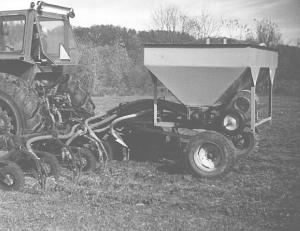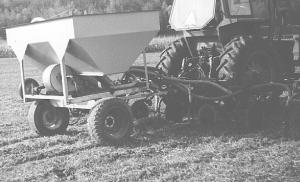1997 - Volume #21, Issue #4, Page #30
[ Sample Stories From This Issue | List of All Stories In This Issue | Print this story
| Read this issue]
"Steerable" Fertilizer Caddy
 |
 |
What makes it unique, according to inventor Roger Montag of Howardstown, Ky., is a steering arm that runs from the axle on the cart to a ball hitch that mounts on the toolbar pulling the cart. The cart's tongue pivots on a separate ball hitch on the toolbar.
The cart itself features a simple air delivery system that Montag invented several years ago for deep placement of fertilizer (Vol. 17, No. 3). The design has been incorporated into equipment produced by several manufacturers.
Montag built the new cart to combine his air system with the "steerable" axle in order to come up with a fertilizer cart that would adapt to many different situations.
"It's a simple, low-cost system. You can use it to do everything from deep banding fertilizer to planting soybeans," says Montag. "We used it last year on more than 1,000 acres, mostly to sidedress dry fertilizer in corn. With the cart behind the toolbar the driver has a great view of the knives. It could also be used to apply preplant fertilizer or it can be used behind a planter to apply herbicides or starter fertilizer. In addition, you can pull it behind a field cultivator or disk to plant soybeans.
"By replacing the hopper and air metering system with a tank and pump, you could use it to apply liquid fertilizer or herbicides. "The steering system keeps the cart from pulling to the left or right and allows it to follow directly behind the implement instead of lagging downhill or in the direction you're turning. When you turn at the end of the field, the cart follows the rows almost as tight as you can turn the planter and, at the end of the turn, it ęsquares up' to come back between the rows immediately without driving over them. The steering system allows the cart to pull easier at the end of the field and also makes it easier to back up.
"It eliminates the need for expensive long hitches that are normally necessary on tow-behind carts to keep from catching on the implement when turning at the end of the field. The short tongue also reduces the blowing distance."
The cart is equipped with a hydraulic-driven blower mounted behind the hopper. The blower sends air into a series of stain-less steel "acceleration chambers" mounted at the bottom of the hopper. Air spins around inside each chamber and picks up fertilizer metered to it by a ground-driven auger in-side the hopper. The spinning air blows the fertilizer through hoses ahead to the toolbar where it's injected into the soil.
"Separate air chambers for each row en-sure that the same amount of fertilizer is de-livered to each row," says Montag.
He expects to have 3-ton (shown in photo) and 5-ton carts available this fall. The 3-ton model will sell for about $2,000 and the 5-ton model for about $3,500.
Contact: FARM SHOW Followup, Roger Montag, 7500 Stiles Rd., Howardstown, Ky. 40051 (ph 502 549-5359).

Click here to download page story appeared in.

Click here to read entire issue
To read the rest of this story, download this issue below or click here to register with your account number.




